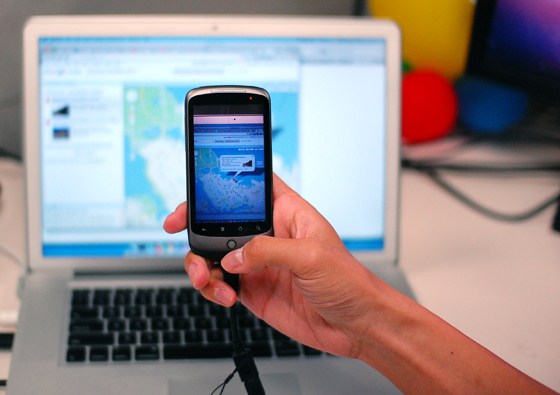
When Deep Shot transfers an open application to a cellphone, it automatically resizes the application window to match the framing of the photo.
Photo: Yang Li
“People are used to using heavy tools to transfer data or synchronize two devices,” Chang says. “You have to plug in a USB cable and maybe open iTunes and synchronize a bunch of data at the same time. But sometimes you just want to send a tiny bit of information, or a single piece of information.”
The system, called Deep Shot, exploits the fact that many Web applications use a standard format, called the uniform resource identifier (URI), to describe the states they’re in. For instance, if you search for directions on Google Maps, then click the link that says “Link,” a window pops up that says “Paste link in email or IM.” The link consists of a long string of symbols, including the addresses of the starting and ending points and codes that indicate their geographical coordinates and the approximate size of the map window. That’s a URI. The data contained in a URI can vary widely, and URIs are a common feature of many Web applications — if sometimes harder to extract than they are with Google Maps.
UR here
Deep Shot requires installing some minimal software on the phone and on all of the computers with which the phone will interact: You might, for instance, want to use the same phone in conjunction with a home desktop, a home laptop, a work desktop and your spouse or children’s computers. When it’s uploading data to a phone, Deep Shot uses existing computer vision algorithms to identify the application open on screen, and then the software installed on the computer extracts and transmits the corresponding URI. Changing the framing of the photograph will also change the framing of the application window that opens on the phone. Conversely, when Deep Shot is downloading data from the phone, the computer vision algorithm identifies the computer that the camera is trained on.
Video: Tsung-Hsiang Chang and Yang Li
Chang and Li developed the system last summer when Chang was doing an internship at Google, and they presented a paper on it at the Association for Computing Machinery’s CHI conference on computer-human interaction in May. At present, the system works with several common Web applications, such as Google Maps and Yelp, and with minimal additional coding it could be made to work with any application that reveals its state through URIs. Since URIs use a standardized set of codes, Deep Shot can also mediate between different applications, transferring data from one map application running on a desktop computer, say, to a different map application installed on a cellphone. In principle, the system could also work with off-the-shelf software: It would just require software developers to make some minimal modifications to their code.
Fanning out
“I find it a really compelling use case, so I would really hope that companies like Microsoft would really consider adding it,” says Jeffrey Nichols, a researcher at IBM’s Almaden research center who specializes in mobile devices. But, he points out, getting Deep Shot to work with desktop software from a lot of different manufacturers would require broad agreement on interoperability standards, which is hard to come by. “I see it being much more likely to happen with websites than with desktop applications,” Nichols says. “On the other hand, to some extent, we’re moving away from desktop applications and moving more and more to the Web, so it’s not clear to me how important it is that we really bring all the native application developers into the fold.”
Moreover, even in cases where Web developers are reluctant to reveal information about the states of their applications, “there are a lot of ways for people who are not even involved in the creation of the website to add features into a website,” Nichols says. “So you could imagine that if the technology gets a foothold in a few places, then even if some websites aren’t willing to add it, then other people might add it for them.”
Since Chang was at Google when he worked on Deep Shot, Google owns the rights to it. Google has not yet made the system publicly available, but when it does, Chang will be among the first to install it, having come to depend on it during the summer he helped invent it. “It just makes everything so much easier,” he says.






